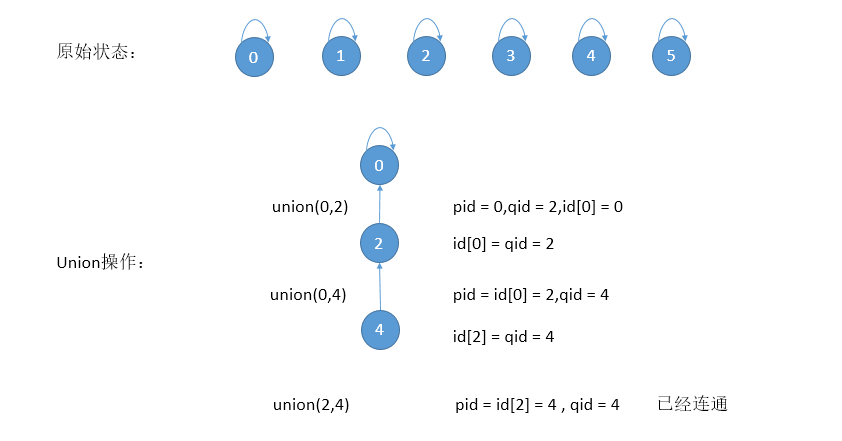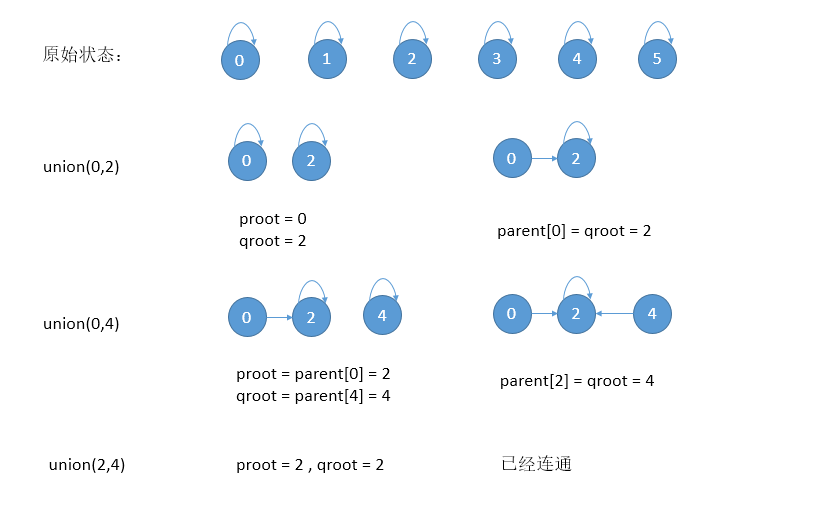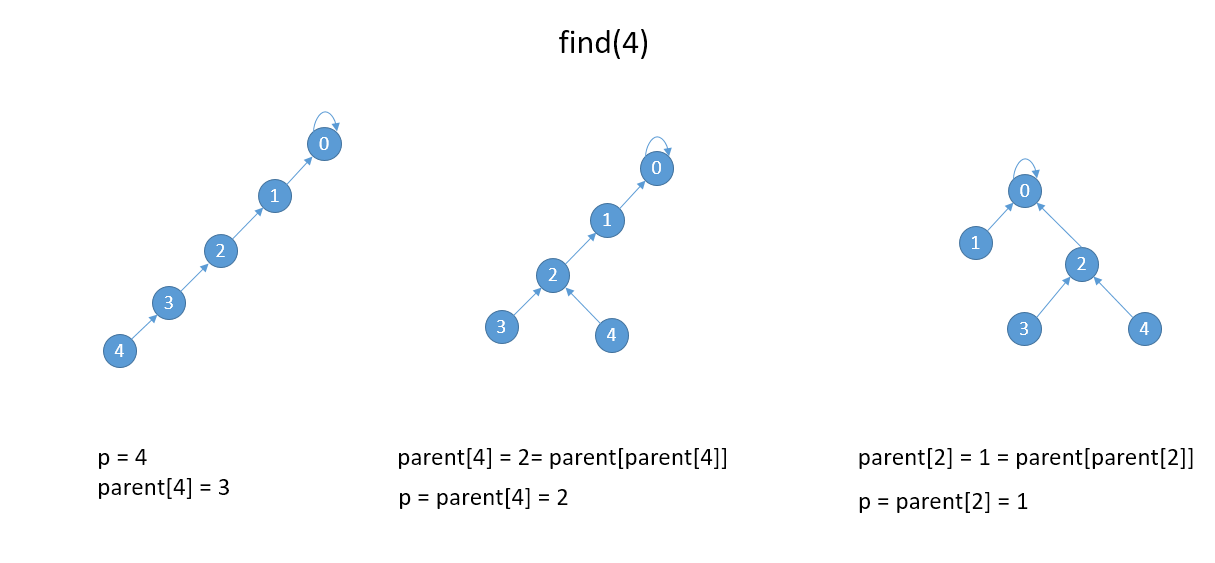并查集(Union-Find)是用于解决动态连通性类问题的一种数据结构。
动态连通性问题
动态连通性问题是一个非常基础的计算性问题,而且它在现实世界中的应用很广泛,庞大的电脑网络、数以亿计的社交网络中的人类、数学集合中的元素、计算机程序中的变量、照片中的像素,都会涉及到动态连通性。
1.这类问题的输入是一列整数对,每个整数都表示一个某种类型的对象,一对整数“p q”表示的含义是“p和q相连”。
2.“相连”是一种等价关系
1) 自反性(p与p相连接);
2) 对称性(若p连接到q,那么q也连接到p);
3) 传递性(若p连接到q,q连接到r,则p连接到r)。
3.等价关系将对象分成多个等价类,它们构成多个集合,称为“连通组件”(Connected Components)。
并查集
对于一组数据,并查集主要支持两个动作,回答一个问题。
动作
1.union(p,q):将p,q连接。
2.find(p):查找p。
问题
isConnected(p,q):检测p,q是否连接并返回布尔值。
举个例子:

我们可以通过union操作,实现上图的连接,形成了两个连通分量,或称为一个组。
实现
Quick-Find实现
1 | id = [] |
备注:上面的实现,只给出了每个函数的实现,其中,有一点需要说明,就是id这个数组。初始化时,每个元素都是指向自己,union操作时,循环遍历id数组,将qid指向pid这条链上的最后一个元素。
具体过程如下所示:

Quick-Union实现
上面的Quick-find实现在规模增大时,会面临性能问题,其主要来源是union操作需要遍历数组,为了改善性能,需要避免执行union操作时遍历数组,Quick-Union实现达到了这一目的。
1 | parent = [] |
具体过程如下所示:

Quick-Union优化
基于元素个数优化
引入一个num[i],用来记录以i为根的集合中元素个数。1
2
3
4
5
6
7num = []
def unionFind(n):
count = n
for i in xrange(count):
parent[i] = i
num[i] = 1
始终保持元素少的根节点指向元素多的根节点,这样有很大的概率可以维护树的高度增长的不是那么快。1
2
3
4
5
6
7
8
9
10
11def union(p, q):
proot = find(p)
qroot = find(q)
if num[proot] < num[qroot]:
parent[proot] = qroot
num[qroot] += num[proot]
else:
parent[qroot] = proot
num[proot] += num[qroot]
基于rank的优化
在上述的优化过程中,只是有很大的概率可以维护树的高度增长的不是那么快。实际上并不准确,更多的时候我们采用的是基于rank的优化。1
2
3
4
5
6
7rank = []
def unionFind(n):
count = n
for i in xrange(count):
parent[i] = i
rank[i] = 1
和上面一种优化相比,区别在于,这里维护的是真正的树的深度,树深小的指向树深大的,只有当相等的时候树深才会加1。1
2
3
4
5
6
7
8
9
10
11def union(p, q):
proot = find(p)
qroot = find(q)
if rank[proot] < rank[qroot]:
parent[proot] = qroot
elif rank[qroot] < rank[proot]:
parent[qroot] = proot
else:
parent[proot] = qroot
rank[qroot] += 1
路径压缩(Path Compression)
先实现第一种路径压缩优化,实际上只需要对find(p)进行一个修改:1
2
3
4
5def find(p):
while p!=parent[p]:
parent[p] = parent[parent[p]]
p = parent[p]
return p
具体过程如下:

可以看到,路径的确被压缩了,但是这仍然不是最优的压缩路径,最优的情况下是如下图这种压缩方式:

使用递归实现:1
2
3
4def find(p):
if p!=parent[p]:
parent[p] = find(parent[p])
return p
以上内容,便是并查集的内容,后续会更新一些笔面试题目,加深应用和理解。
